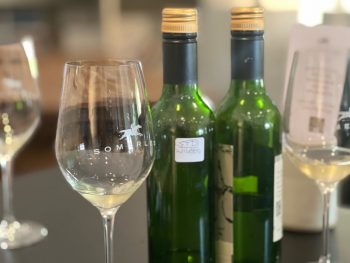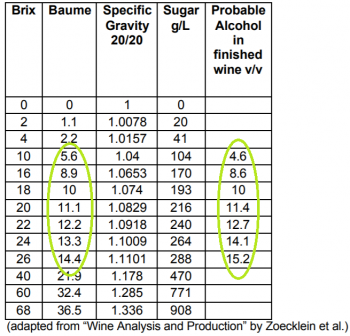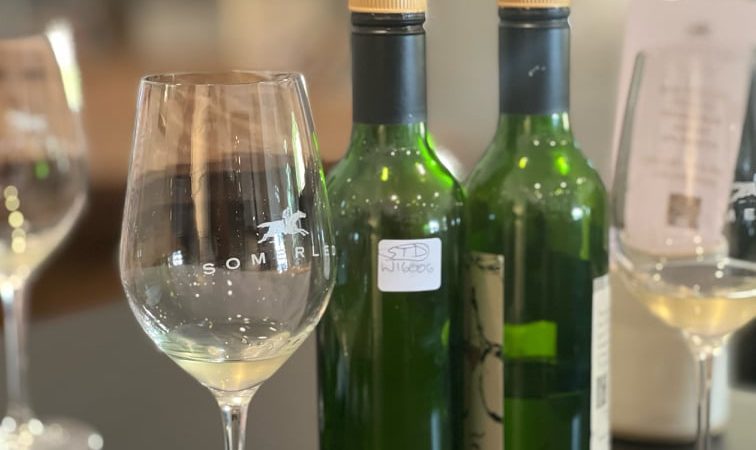 Yesterday, Rob and Heather had a tasting of our brand new, soon to hit the bottling line 2021 Chardonnay.
Yesterday, Rob and Heather had a tasting of our brand new, soon to hit the bottling line 2021 Chardonnay.
(Along with a couple of barrels that will become our next Reserve Chardonnay – more news on this to come!)
That’s right Chardonnay fans, it’s on its way back! The plan is for it to be bottled at the end of this month. Which mean it will be in your glass before too long. And will be in your March Jockey Club packs.
Hang on… what do you mean you don’t like Chardonnay?!
In my experience, Chardonnay is one of our most divisive varieties. By far the most common request amongst our Jockey Club members when it comes to pack changes is… “Send me anything but Chardonnay”!
Are you a proud member of the “ABC” (Anything But Chardonnay) club?
Let’s see if we can’t get to the bottom of why this club boasts so many members…
Everyone blames the oak…
Yes, it’s fair to say that it’s the Chardonnay’s which have seen a lot of oak that tend to put people off. But it comes down to a lot more than just that.
In fact, the reason winemakers use so much oak is that Chardonnay grapes are actually quite neutral in character.
Because it is both neutral and adaptable to many environments, Chardonnay becomes a blank canvas for winemakers to create any style they choose.
Today, Chardonnay is planted in every major wine-producing country, which can greatly affect the structure and fruit quality of the resulting wine. Cooler climates produce Chardonnay wines with higher acidity, lighter body and restrained fruit character. Whereas warmer climates can produce big, alcoholic Chardonnays with intense flavours.
Before we go any further, bear with me while I take you through a quick chemistry lesson…
Sugar and alcohol
As you would remember from this post, the amount of sugar in the grapes at picking provides an estimate of the percentage of alcohol in the resulting wine. Remembering that the ripeness of the grapes is measured in something called degrees Baumé (Bé°), I might have said something along the lines of… 1 Bé° roughly equates to 1 % alcohol in the finished wine. So, if the Baumé of the fruit when it’s picked is 12 Bé°, then it should produce a wine of around 12% alcohol.
Now, while this is a pretty well-accepted rule of thumb, but it’s not quite right.

You see, Baumé doesn’t actually measure the sugar content in grape juice. All it does is measure the specific gravity (or density) of the solution. And given that sugar makes up around 90-95% of the solids in grapes juice then it’s a “close enough” guess of the sugar content.
And while this rule of thumb is generally pretty close for Baumés around the 10 and 11 mark, it starts to get less accurate the higher you go. I found this table which might help explain it.
You can see that the higher the Baumé the less accurate the 1:1 ratio becomes.
Why are you telling me all this?
(I hear you moan!)
There is a point, I promise!
So, back in the early days of Chardonnay, winemakers tried to create wines with a lot of flavour. Probably overcompensating for the fact that the variety is inherently neutral in flavour and aroma. To achieve this, they left the fruit on the vine. for WAY too long.
As we know, the longer you leave the fruit on the vine, the sweeter it gets. We also know that the sweeter the grape juice, the more alcohol it produces. But now we know that the level of alcohol increases exponentially. So, what winemakers were left with was a highly alcoholic wine, with very little acidity (which would have been adjusted in the winery). Throw into the mix a good dose of oak and what you get is an absolutely pungent wine with massively intense flavours.
No wonder people were turned off it!
Loving our blog? Sign up for weekly updates straight to your inbox…
How to make a (very) drinkable Chardonnay
Chardonnay is a fruit-forward grape, with flavours ranging from fresh citrus to overblown tropical fruits. Pretty much anything is possible with Chardonnay. It is such a flexible variety and easily translates the terroir of the region in which it is produced. Chardonnay can have accents of subtle flower blossoms, raw almond, toasted nuts, parmesan cheese, mushroom, honey, white stonefruit and more!
But the key to a good chardonnay is in the winemaking processes used for this grape. Malolactic fermentation can add those buttery, dairy-like aromas and flavours. And oak ageing is responsible for those stereotypical vanilla, cinnamon and nutmeg notes.
Chardonnay is in Rob’s Top 5 favourite grape varieties of all time. So, it’s no surprise that his interpretation can convert even the most strident Chardonnay hater. And here is how he does it…
- pick the fruit nice and early – at around 12-12.5 Bé° to retain the crisp acidity in the wine
- take the wine all the way through malolactic fermentation to soften the sharp acids
- never use American oak as the flavour can be too over the top for Chardonnay (it’s better for red wines)
- never use new oak barrels – seasoned (or barrels which have been used before) ensure the oak characters aren’t too over-powering
- make sure you have over 50 years of winemaking experience!
If you haven’t tried Rob’s Chardonnay… I beg you, don’t write the variety off just yet. You don’t know what you’re missing out on!
And what of our 2021 version?
Well, Heather gives it the big thumbs up!


Hey we lovers of a fine chardonnay! Both wooded and unwooded… we don’t discriminate. Only on quality. Somerled chardonnay has always been a winner x
Leave the ABC to drink nothing but tea
This leaves more Chardonnay for others and me
All Rob’s hard work to produce this drink
All would enjoy it, you would think
Those that do not should be asked to take part
Of a blind tasting with the bottles (in the dark) (as in paper bag)
If still after that they they do not sway
Then it is certain they do not deserve
Rob’s Chardonnay
Maree and Heather, this blog has motivated me to get a Somerled Chardy out of the wine fridge to have this evening!
What a shame I can’t get Stirling Chicken and chips delivered to Melbourne….
See you soon for a chilled one at the Cellar Bar
I’m very much looking forward to a visit and several glasses of that chardy in the near future. Hope you’re all well xx
Froggy… that was amazing! You win comment of the year 🙂
Such a shame!
Can’t wait to see you again soon xx
Of course, you’re a lover Jill!